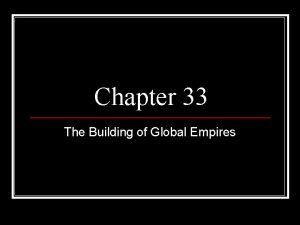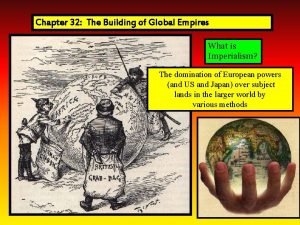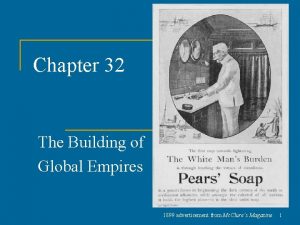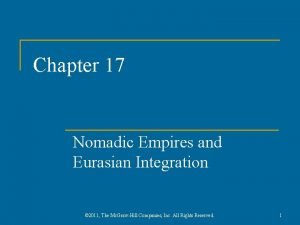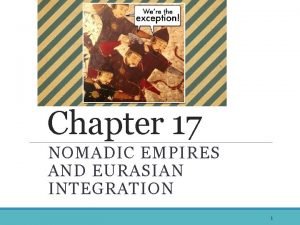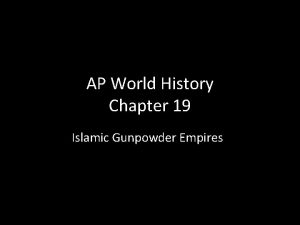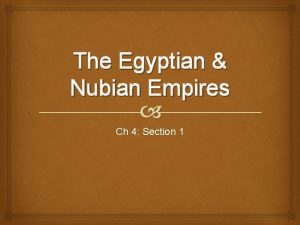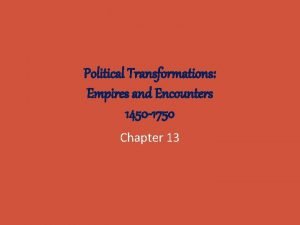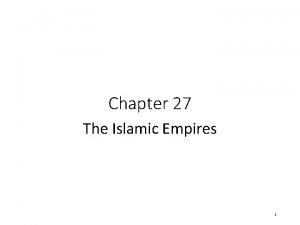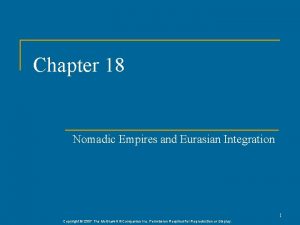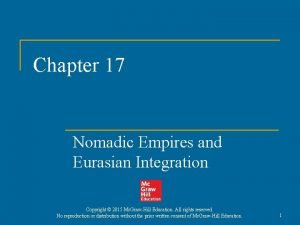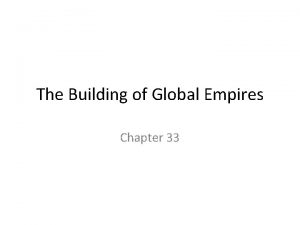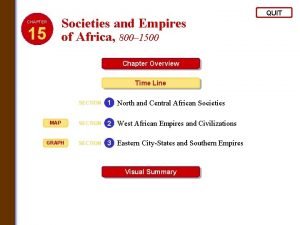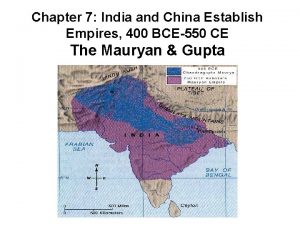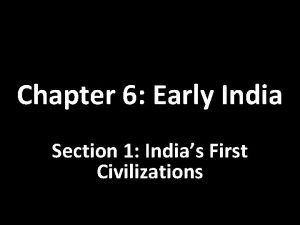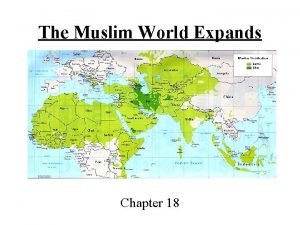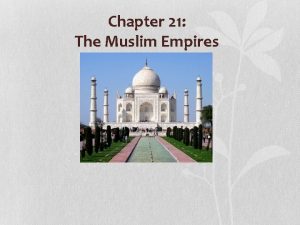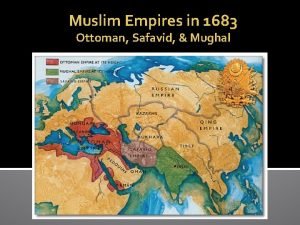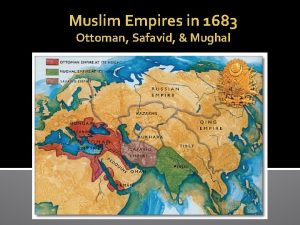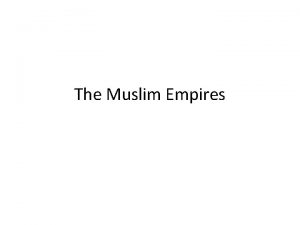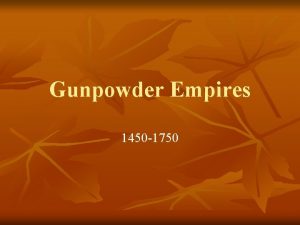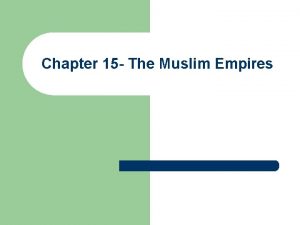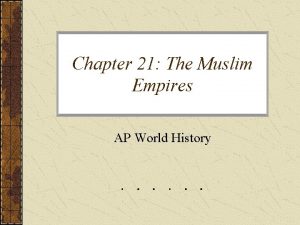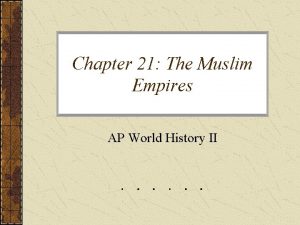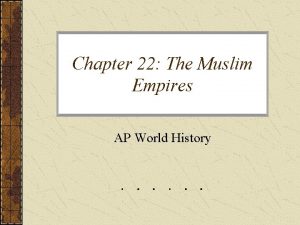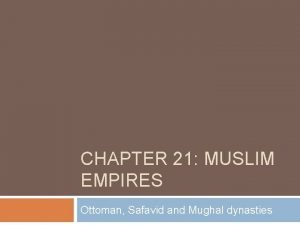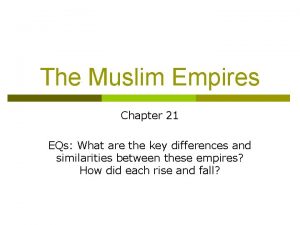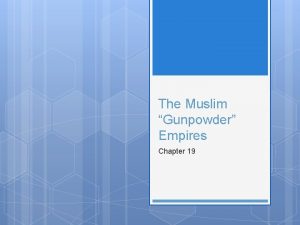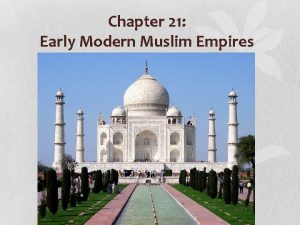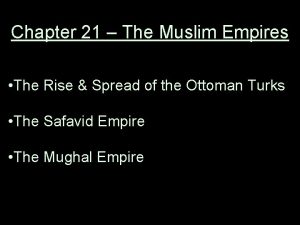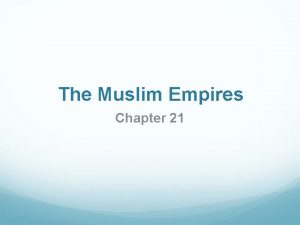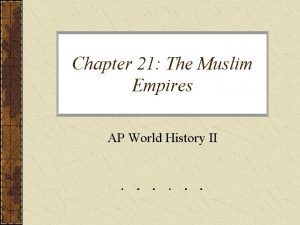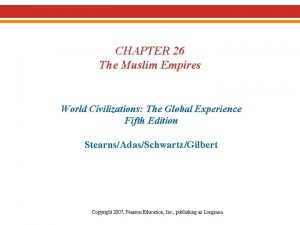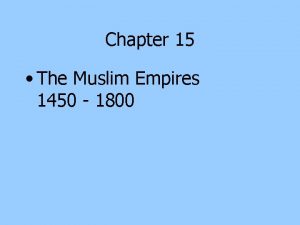Chapter 21 The Muslim Empires Chapter 21 Stearns


























- Slides: 26

Chapter 21: The Muslim Empires Chapter 21 Stearns et al. , World Civilizations, The Global Experience, AP* Edition, 5 th Edition Pearson Education, Inc. publishing as Longman, Copyright 2007

Chapter 21: The Muslim Empires I. The Ottomans: From Frontier Warriors to Empire Builders II. The Shi’a Challenge of the Safavids III. The Mughals and the Apex of Muslim Civilization in India Stearns et al. , World Civilizations, The Global Experience, AP* Edition, 5 th Edition Pearson Education, Inc. publishing as Longman, Copyright 2007

Chapter 21: The Muslim Empires The Ottoman, Safavid and Mughal Empires Stearns et al. , World Civilizations, The Global Experience, AP* Edition, 5 th Edition Pearson Education, Inc. publishing as Longman, Copyright 2007

Chapter 21: The Muslim Empires Stearns et al. , World Civilizations, The Global Experience, AP* Edition, 5 th Edition Pearson Education, Inc. publishing as Longman, Copyright 2007

Chapter 21: The Muslim Empires The Ottomans: From Frontier Warriors to Empire Builders Mid-1200 s, Mongols defeat Seljuks (From the crusades) Ottomans emerge dominant over Byzantines Rename: Istanbul Expansion – all former Eastern Roman Empire Positive Correlation: Religious Persecution & Expansion Stearns et al. , World Civilizations, The Global Experience, AP* Edition, 5 th Edition Pearson Education, Inc. publishing as Longman, Copyright 2007

Chapter 21: The Muslim Empires “The Ghazi is the instrument of the religion of Allah, a servant of God who purifies the earth from the filth of Polytheism; the Ghazi is the sword of God, he is the protector and the refuge of the believers. If he becomes a martyr in the ways of God, do not believe that he has died – he lives in beatitude with Allah, he has eternal life. ” -Poet Ahmadi (describing the Ottoman ethos) What does it sound like the “Ghazi” are? What can we learn about the Ottomans from this passage? Stearns et al. , World Civilizations, The Global Experience, AP* Edition, 5 th Edition Pearson Education, Inc. publishing as Longman, Copyright 2007

Chapter 21: The Muslim Empires A State Geared to Warfare Devshirme Conquered peoples (Balkans) had to send young boys -learned Turkish -specially trained -converted to Islam 2 Options -Ottoman civilian administration -Janissaries – conscripted soldiers Stearns et al. , World Civilizations, The Global Experience, AP* Edition, 5 th Edition Pearson Education, Inc. publishing as Longman, Copyright 2007

Chapter 21: The Muslim Empires Stearns et al. , World Civilizations, The Global Experience, AP* Edition, 5 th Edition Pearson Education, Inc. publishing as Longman, Copyright 2007

Chapter 21: The Muslim Empires The Sultans and their Court Sultan – held title of Caliph Vizier - Head of large bureaucracy Imperial Council Provinces Districts – responsible for collecting taxes/supplying armies Stearns et al. , World Civilizations, The Global Experience, AP* Edition, 5 th Edition Pearson Education, Inc. publishing as Longman, Copyright 2007

Chapter 21: The Muslim Empires Constantinople Restored and the Flowering of Ottoman Culture Responsible: Suleiman I Commercial center Suleymaniye mosque, 16 th century Turkish Language prevails Produced pottery, rugs, silk, jewelry, arms & armor Stearns et al. , World Civilizations, The Global Experience, AP* Edition, 5 th Edition Pearson Education, Inc. publishing as Longman, Copyright 2007

Chapter 21: The Muslim Empires Ottoman Society Restrictions on women but Turkic roots 4 Main Occupational Groups Peasants – leased land from the state Artisans – organized in craft guilds Merchants – highest status Pastoral People – own regulations and laws Stearns et al. , World Civilizations, The Global Experience, AP* Edition, 5 th Edition Pearson Education, Inc. publishing as Longman, Copyright 2007

Chapter 21: The Muslim Empires The Shi’a Challenge of the Safavids Starts with Safavid family Ismâ'il takes Tabriz Ardent Shiite – actively attempt to convert Named shah - title The Safavid Empire Stearns et al. , World Civilizations, The Global Experience, AP* Edition, 5 th Edition Pearson Education, Inc. publishing as Longman, Copyright 2007

Chapter 21: The Muslim Empires Battle of Chaldiran, 1514 https: //www. flickr. com/photos/125761528@N 06/19017308766/in/photostream Stearns et al. , World Civilizations, The Global Experience, AP* Edition, 5 th Edition Pearson Education, Inc. publishing as Longman, Copyright 2007

Chapter 21: The Muslim Empires Abbas I (1587 -1629) -Height of Safavid Empire Persians as bureaucrats – Balance out warrior leaders Europeans saw him as an ally Adopt Persian language and court traditions after Chaldiran Patron of the arts & trade Building projects Roads and Rest Houses Mosques in Isfahan Stearns et al. , World Civilizations, The Global Experience, AP* Edition, 5 th Edition Pearson Education, Inc. publishing as Longman, Copyright 2007

Chapter 21: The Muslim Empires Religion in the Safavid World Abandoned egalitarian camaraderie Shi'ism modified Spreads to entire empire Orthodoxy Dominates Women forced into seclusion and required to wear a veil Stearns et al. , World Civilizations, The Global Experience, AP* Edition, 5 th Edition Pearson Education, Inc. publishing as Longman, Copyright 2007

Chapter 21: The Muslim Empires Society and Gender Roles: Ottoman and Safavid Commonalities Warrior aristocracies Move to rural estates after conquest Threat to central power Imperial workshops Artisans patronized International trade encouraged Women Court: Influence Ordinary: Trade & money-lending BUT mostly confined to their homes (embroidery) Stearns et al. , World Civilizations, The Global Experience, AP* Edition, 5 th Edition Pearson Education, Inc. publishing as Longman, Copyright 2007

Chapter 21: The Muslim Empires The Mughals and the Apex of Muslim Civilization in India Babur – Mongol & Turkic Descent Driven from Afghanistan Invades India, 1526 – Not as religiously motivated Battle of Panipat Stearns et al. , World Civilizations, The Global Experience, AP* Edition, 5 th Edition Pearson Education, Inc. publishing as Longman, Copyright 2007

Chapter 21: The Muslim Empires Akbar and the Basis for a Lasting Empire 13 -year-old son of Humayn Battles with everyone & wins Reconciliation with Hindus (No more Jizya) New religion, Din-i-Ilahi Blend of Islam and Hinduism Toleration Stearns et al. , World Civilizations, The Global Experience, AP* Edition, 5 th Edition Pearson Education, Inc. publishing as Longman, Copyright 2007

Chapter 21: The Muslim Empires B. Social Reform and Social Change Continuity: Muslim rulers and public works Women Widows encouraged to remarry and child marriages discouraged Sati prohibited Seclusion undermined by women's market days C. Mughal Splendor and Early European Contacts Death of Akbar Reforms don't survive Empire strong Cotton textiles to Europe Especially among laboring and middle classes Stearns et al. , World Civilizations, The Global Experience, AP* Edition, 5 th Edition Pearson Education, Inc. publishing as Longman, Copyright 2007

Chapter 21: The Muslim Empires D. Artistic Achievement in the Mughal Era Successors: Jahangir and Shah Jahan, 17 th century Continue toleration Less energetic Support arts Taj Mahal Stearns et al. , World Civilizations, The Global Experience, AP* Edition, 5 th Edition Pearson Education, Inc. publishing as Longman, Copyright 2007

Chapter 21: The Muslim Empires E. Court Politics and the Position of Elite and Ordinary Women Nur Jahan Wife of Jahangir Head of powerful faction Mumtaz Mahal Wife of Shah Jahan – Buried in Taj Mahal Also powerful, her husband was more competent Ordinary women Position declines Age limit lowered for child marriage Sati spreads among upper classes Birth of girl was undesirable - dowry Stearns et al. , World Civilizations, The Global Experience, AP* Edition, 5 th Edition Pearson Education, Inc. publishing as Longman, Copyright 2007

Chapter 21: The Muslim Empires Autopsy Stearns et al. , World Civilizations, The Global Experience, AP* Edition, 5 th Edition Pearson Education, Inc. publishing as Longman, Copyright 2007

Chapter 21: The Muslim Empires D. The Problem of Ottoman Decline Strong until late 1600 s Infrastructure insufficient Dependent on conquest - End of conquest brings deficiencies Regional leaders divert revenue Stearns et al. , World Civilizations, The Global Experience, AP* Edition, 5 th Edition Pearson Education, Inc. publishing as Longman, Copyright 2007

Chapter 21: The Muslim Empires E. Military Reverses and the Ottoman Retreat Fail at the Siege of Vienna Lepanto, 1571 Defeated by Spain, Venice - Turks lose control of eastern Mediterranean Portuguese outflank Middle East trade Sail around Africa into Indian Ocean Victories over Muslim navies Inflation Caused by New World bullion Comes at same time as loss of revenue from control of trade Stearns et al. , World Civilizations, The Global Experience, AP* Edition, 5 th Edition Pearson Education, Inc. publishing as Longman, Copyright 2007

Chapter 21: The Muslim Empires The Rapid Demise of the Safavid Empire Abbas I Removes heirs Weak grandson inherits Decline begins Internal conflict, outside threats 1772, Isfahan taken by Afghanis Stearns et al. , World Civilizations, The Global Experience, AP* Edition, 5 th Edition Pearson Education, Inc. publishing as Longman, Copyright 2007

Chapter 21: The Muslim Empires F. The Beginnings of Imperial Decline Aurangzeb takes over a mess 2 Ambitions Rule all India Cleanse Islam of Hindu taint 1707, controls most of India Expensive, distracting Other developments disregarded Revolt Autonomy of local leaders Hindus excluded from high office Non-Muslims taxed Marattas and Sikhs challenge rule Stearns et al. , World Civilizations, The Global Experience, AP* Edition, 5 th Edition Pearson Education, Inc. publishing as Longman, Copyright 2007
 Maritime vs land based empires
Maritime vs land based empires Tom stearns eliot
Tom stearns eliot Birth place ts
Birth place ts Eugene stearns
Eugene stearns Stearns
Stearns Stearns farm stand
Stearns farm stand Sarah stearns psychologist
Sarah stearns psychologist Bill stearns
Bill stearns Chapter 33 the building of global empires
Chapter 33 the building of global empires Chapter 32: the building of global empires
Chapter 32: the building of global empires Chapter 32 the building of global empires
Chapter 32 the building of global empires Chapter 17 nomadic empires and eurasian integration
Chapter 17 nomadic empires and eurasian integration Nomadic empires and eurasian integration
Nomadic empires and eurasian integration Chapter 19 islamic gunpowder empires
Chapter 19 islamic gunpowder empires Chapter 4 section 1 the egyptian and nubian empires
Chapter 4 section 1 the egyptian and nubian empires Chapter 5 political transformations empires and encounters
Chapter 5 political transformations empires and encounters Chapter 27 the islamic empires
Chapter 27 the islamic empires Chapter 27 the islamic empires
Chapter 27 the islamic empires Chapter 18 nomadic empires and eurasian integration
Chapter 18 nomadic empires and eurasian integration Chapter 17 nomadic empires and eurasian integration
Chapter 17 nomadic empires and eurasian integration Chapter 16 people and empires in the americas
Chapter 16 people and empires in the americas Chapter 33 the building of global empires
Chapter 33 the building of global empires Chapter 15 societies and empires of africa
Chapter 15 societies and empires of africa Chapter 7 section 1 india's first empires
Chapter 7 section 1 india's first empires Chapter 7 india and china establish empires
Chapter 7 india and china establish empires Chapter 7 section 1 india's first empires
Chapter 7 section 1 india's first empires Chapter 18: the muslim world expands answer key
Chapter 18: the muslim world expands answer key








